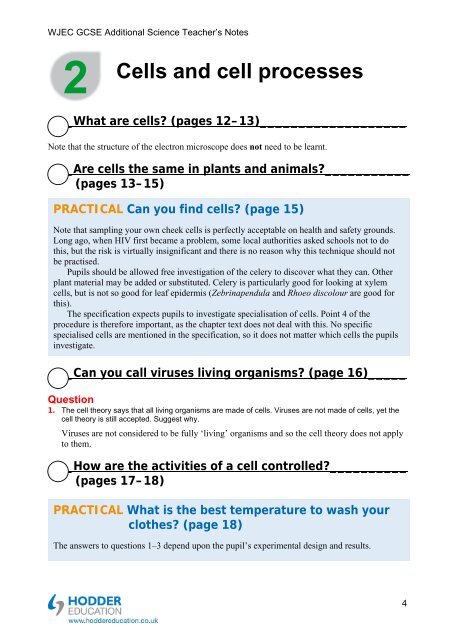Teacher's notes and answers to questions in the book - Hodder Plus ...
Teacher's notes and answers to questions in the book - Hodder Plus ...
Teacher's notes and answers to questions in the book - Hodder Plus ...
You also want an ePaper? Increase the reach of your titles
YUMPU automatically turns print PDFs into web optimized ePapers that Google loves.
WJEC GCSE Additional Science Teacher’s Notes<br />
2<br />
Cells <strong>and</strong> cell processes<br />
_What are cells (pages 12–13)___________________<br />
Note that <strong>the</strong> structure of <strong>the</strong> electron microscope does not need <strong>to</strong> be learnt.<br />
_Are cells <strong>the</strong> same <strong>in</strong> plants <strong>and</strong> animals___________<br />
(pages 13–15)<br />
PRACTICAL Can you f<strong>in</strong>d cells (page 15)<br />
Note that sampl<strong>in</strong>g your own cheek cells is perfectly acceptable on health <strong>and</strong> safety grounds.<br />
Long ago, when HIV first became a problem, some local authorities asked schools not <strong>to</strong> do<br />
this, but <strong>the</strong> risk is virtually <strong>in</strong>significant <strong>and</strong> <strong>the</strong>re is no reason why this technique should not<br />
be practised.<br />
Pupils should be allowed free <strong>in</strong>vestigation of <strong>the</strong> celery <strong>to</strong> discover what <strong>the</strong>y can. O<strong>the</strong>r<br />
plant material may be added or substituted. Celery is particularly good for look<strong>in</strong>g at xylem<br />
cells, but is not so good for leaf epidermis (Zebr<strong>in</strong>apendula <strong>and</strong> Rhoeo discolour are good for<br />
this).<br />
The specification expects pupils <strong>to</strong> <strong>in</strong>vestigate specialisation of cells. Po<strong>in</strong>t 4 of <strong>the</strong><br />
procedure is <strong>the</strong>refore important, as <strong>the</strong> chapter text does not deal with this. No specific<br />
specialised cells are mentioned <strong>in</strong> <strong>the</strong> specification, so it does not matter which cells <strong>the</strong> pupils<br />
<strong>in</strong>vestigate.<br />
_Can you call viruses liv<strong>in</strong>g organisms (page 16)_____<br />
Question<br />
1. The cell <strong>the</strong>ory says that all liv<strong>in</strong>g organisms are made of cells. Viruses are not made of cells, yet <strong>the</strong><br />
cell <strong>the</strong>ory is still accepted. Suggest why.<br />
Viruses are not considered <strong>to</strong> be fully ‘liv<strong>in</strong>g’ organisms <strong>and</strong> so <strong>the</strong> cell <strong>the</strong>ory does not apply<br />
<strong>to</strong> <strong>the</strong>m.<br />
_How are <strong>the</strong> activities of a cell controlled__________<br />
(pages 17–18)<br />
PRACTICAL What is <strong>the</strong> best temperature <strong>to</strong> wash your<br />
clo<strong>the</strong>s (page 18)<br />
The <strong>answers</strong> <strong>to</strong> <strong>questions</strong> 1–3 depend upon <strong>the</strong> pupil’s experimental design <strong>and</strong> results.<br />
4

















